Women and Church Leadership
Written by E. Margaret Howe Reviewed By Timothy P. WeberBooks on the so-called ‘women’s issue’ in the church are legion. Margaret Howe, a Manchester-trained biblical scholar who teaches at Western Kentucky University, has written one of the best. Writing from an evangelical perspective with its high view of Scripture, Professor Howe challenges her readers to think carefully and rather non-traditionally about the roles that women play in the church.
In many evangelical circles, discussion of this topic comes to a speedy end with a few rather perfunctory quotations from St Paul. Howe, however, thinks that the issue is more complicated than that. She shows, for example, how misleading modern translations of the Bible, unfamiliarity with the first century milieu, and a failure to grasp the extent to which modern culture shapes our perspective can produce inconsistent and even muddled thinking. She tackles the crucial texts (Gn. 1–3, 1 Tim. 2, 1 Cor. 11 and 14, and Eph. 5), arguing that ‘traditionalists’ have not done justice to the complexity and subtlety of the biblical material. Her outlook is clearly more holistic than proof-textual. She takes a ‘common sense’ approach to the problem of distinguishing between cultural and trans-cultural elements in Scripture, without establishing any clear-cut guidelines for telling the difference. Though her exegesis probably will not change too many minds among the already convinced, she will force most other readers to ask new questions of the text, which is no small accomplishment.
Much to her credit, Howe recognizes that how (or even whether) women serve in leadership positions ultimately depends on how the various offices are viewed. Many Christians, for example, allow women to teach, but not to pastor. Others permit them to serve as deacons (or deaconesses), but never to be elders. Howe argues that such distinctions have little biblical support. In what may be the most provocative part of the book, Howe shows that the New Testament gives precious little concrete information on the scope, function, and responsibilities of church offices. She sees tremendous overlap in the activities of bishops, elders, deacons, prophets, teachers, and evangelists. Since one is hard pressed to say definitely how these offices operated in early Christian communities, one has little basis on which to permit women in certain offices, but not in others. Howe concludes that because New Testament churches organized themselves primarily around pragmatic and practical concerns, Christians today have the same right. Clearly, then, Howe’s view of the early church’s flexibility and diversity opens the door to an increased role for women today.
Similarly, in a more historical vein, Howe shows that once a ‘prophetic’ view of the ministry gave way to notions of priesthood and celibacy, women were systematically denied leadership roles. Whereas she can demonstrate easily enough changes in the church’s early view of ministry, she has a more difficult time establishing the presence of women in church offices before the change took place. As I think she would have to agree, much more work needs to be done in that area. Currently available evidence seems quite thin.
In addition to presenting generally helpful biblical and historical material, Howe brings her readers up to date on how women are currently doing in leadership roles. After summarizing the official positions of a number of church groups on this issue, she offers the results of her own survey of women who are studying for the ministry in American seminaries or serving in some form of vocational ministry. The picture is not always positive. Insensitive professors, prejudiced fellow-students, suspicious congregations, threatened pastoral peers, and poor self image often get in the way of professional advance and meaningful ministry. But Howe is hopeful. Many women are making it in the ministry. Many more would, if given the chance. Here Howe does the evangelical churches a great service. She presents the human side of what often remains a rather academic and theological issue. The women in her survey are called, committed, and capable. They want to serve Christ and his church. They are willing to suffer disappointment and injustice in order to do so. While not everyone will be convinced by Howe’s exegetical and theological reasoning, they should be moved by the responses of those women who feel called to serve God in professional ministry but who find the going tough. Howe’s survey should shatter any remaining evangelical illusion: the ‘women’s issue’ is not going away. Like it or not, evangelicals must decide whether they are willing—on whatever grounds—to keep the doors shut to ministry-oriented women such as these.
Timothy P. Weber
Denver Seminary







